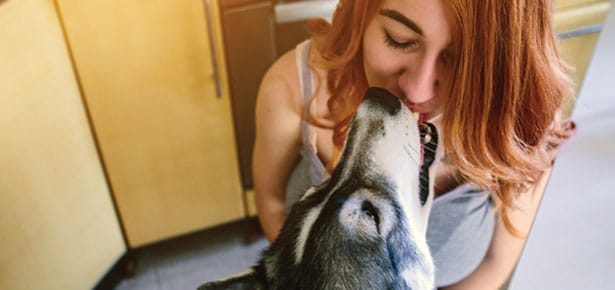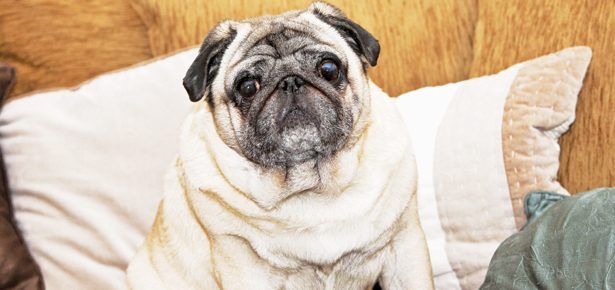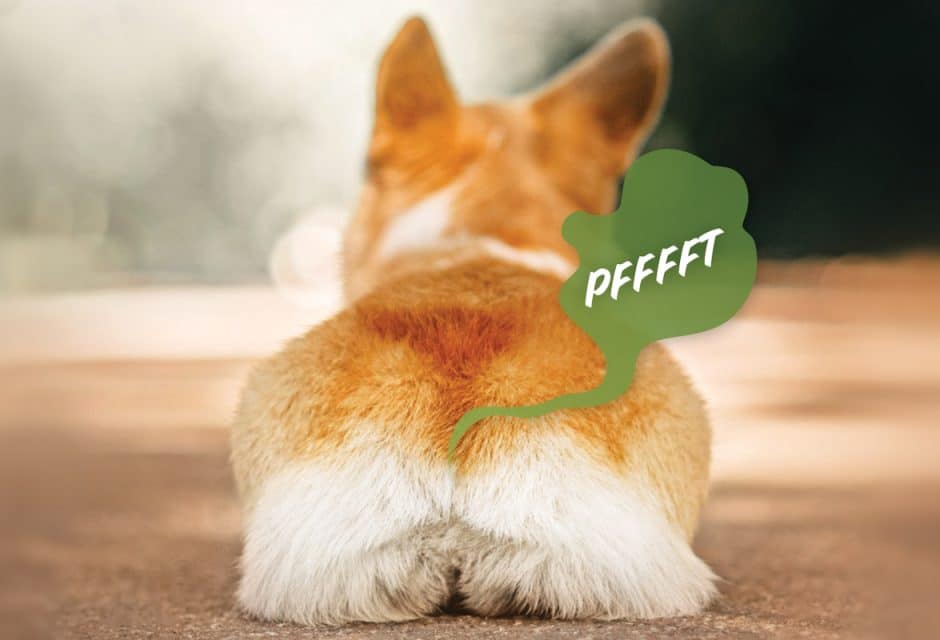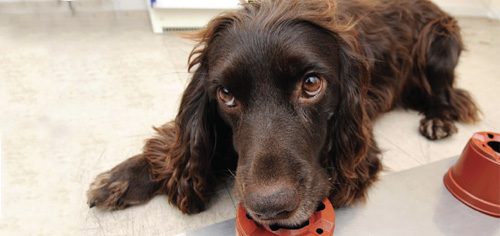
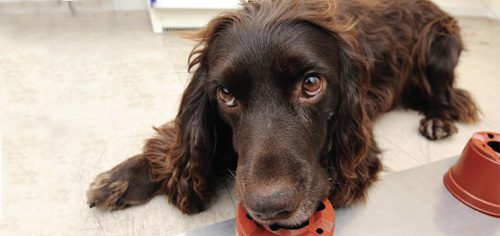
Canine Cancer Detectives
Researchers have uncovered a surprising new diagnostic tool in the fight against cancer: dogs
When Steve Werner began to experience a ringing in his ears and general malaise, he attributed it to nothing more than grief. Camden, one of his two beloved dogs, had just passed away and he believed that his condition was simply a side effect of the anguish he and his surviving Golden Retriever, Wrigley, shared. For weeks, Werner and Wrigley spent most of their days curled up together, bonded in their sadness and heartache at the loss of a friend.
As Werner’s symptoms persisted, he decided to visit his doctor to try and pinpoint the cause of his malady. All the tests came back negative and his doctors were left dumbfounded as to the possible reason for his discomfort. Without a diagnosis or any evident cause for concern, Werner returned home but was left with the uneasy feeling that something wasn’t right. Then Wrigley’s behaviour abruptly changed. Instead of lying calmly next to Werner, she began to obsessively sniff at his right ear. At first Werner thought Wrigley’s inquisitiveness was a gesture of companionship, but once she focused her fixation on the opening of his ear canal, he began to worry that maybe she was trying to tell him something. His anxieties reached a pinnacle after watching a segment on 60 Minutes about dogs who were trained to detect impending epileptic seizures, identify tuberculosis, and detect cancer. Werner began to suspect that Wrigley had discovered something that his doctors had missed.
He decided to revisit his doctor and insist upon further testing. After undergoing an MRI, it was revealed that Werner had a tumour the size of a ping-pong ball surrounding his auditory and vestibular nerves on the right side of his head—the same side Wrigley had been focused on. His particular tumour was benign, but could still have resulted in facial paralysis, hearing loss, and stroke. Werner underwent surgery to have the tumor removed, suffering some temporary facial paralysis from the procedure, but eventually made a full recovery. Suffice it to say upon his return home he was happy to find that Wrigley had no interest in the right side of his head.
Wrigley is not alone in her ability to miraculously identify an otherwise undiagnosed disease. In fact, recent studies have confirmed that dogs have the ability to detect cancer and other diseases in humans using only their sense of smell. Scientists believe that this results from their ability to recognize the different chemical signature that tumourous cells emit when compared to healthy cells. Thanks to the unique biological design of your dog’s nose, his sense of smell is anywhere between 10,000 and 100,000 times more powerful than a human’s (so think twice the next time you leave those dirty socks lying around!). While it is still unclear what makes a dog’s olfactory capabilities so extraordinary, it is evident that much more of a dog’s brain is devoted to this particular sense. Dogs also have a much greater convergence of specialized neurons responsible for smell, from the nose to the olfactory bulb in the brain, and much larger olfactory receptors, scent membranes located within the nose. The receptors found in a human tend to be the size of a postage stamp, while those found in dogs can be as large as a handkerchief.
Due to the influx of patients claiming to have been diagnosed by their dogs, doctors and researchers began to plan the next step in investigating these claims. In 2004, Carolyn Willis of the Amersham Hospital in the UK teamed up with the Hearing Dogs for Deaf People organization and trainer Andy Cook to prove that dogs can diagnose bladder cancer using their heightened olfactory sense. Six dogs of varying breeds lacking any previous scent detection experience were selected and trained to discriminate between urine from patients with cancer and urine from patients who were cancer-free. Each dog was given the opportunity to “sniff test” each of the six samples and then present their diagnosis by sitting down in front of the cancerous sample.
After conducting the controlled test numerous times, researchers began to express their doubts about the dogs’ accuracy because each of the six canines gave a false positive diagnosis to a “cancer-free” sample. The trainers’ attempts to direct the dogs past this particular sample failed, leaving them disheartened and doubtful of the dogs’ previous success. The medical staff, however, had witnessed firsthand the dogs’ ability to precisely locate a cancerous urine sample and believed that something must be throwing them off. They opted to have the urine re-examined by a specialist to confirm that it came from a non-cancerous patient. Further testing led to the discovery that the person providing the sample actually had a kidney tumor and undiagnosed bladder cancer.
Needless to say, the results of this study were promising—the overall average success rate of the dogs was found to be greater than that of state-of-the-art x-ray or CAT scan machines. This revelation silenced many skeptics and disbelievers and gave hope to researchers that these canine specialists could be used in their fight against cancer.
In the hopes of continuing these types of studies, organizations such as the UK-based Cancer and Bio-Detection Dogs (CBDD) are training canines in scent detection for use in the research phase. Like several other types of service animals, the dogs selected show specific attributes that make them viable prospects for detection, such as a high scent drive and being self-rewarded by the activity itself. Dogs that are overly eager to please are not ideal candidates as they often falsely identify in the hope of receiving praise. According to Claire Guest, CEO of CBDD, theoretically, any dog can be trained in detection; however, working gundog breeds such as Labs and spaniels seem to excel as a result of their keen sense of smell and concentration.
This isn’t to say that a dog has to be trained in the art of smelling to succeed in detection. Just ask Gillian Lacey, whose Dalmatian, Trudi, diagnosed her with life-threatening skin cancer when Lacey was just 19. Lacey became suspicious when she noticed that Trudi was sniffing attentively at her owner’s leg. Her first thought was that she must have spilt something on herself to have merited this level of scrutiny. Upon closer inspection though, Lacey realized Trudi was concentrating on a small mole on her leg. The dog became obsessed with Lacey’s mole and would sniff, lick, and paw at it, seeming to have developed a genuine dislike for the area.
Acting upon the counsel of her persistent DP (dog practitioner), Lacey finally decided to consult her family doctor, although she did wonder whether he would think Trudi’s attentions were a foolish impetus for a visit. Though her doctor did not think she was crazy, he assured Lacey that it was likely nothing. He did, however, agree to remove the mole just in case. Much to the doctor’s surprise, a biopsy revealed that the mole was malignant and required a more invasive operation to remove the cancerous tissues, which, mercifully, had not metastasized.
Despite her doctor’s assertions that all of the cancer had been removed, Lacey was terrified at the prospect of being diagnosed with life-threatening cancer, especially at such a young age. She opted to seek out a second opinion—Trudi. Once her Dalmatian’s behaviour returned to normal, she finally felt confident that the cancer was gone. Although Trudi has long since passed on, Lacey still attributes her own survival to her spotted saviour.
So will annual physical exams now be conducted by Dr. Dog? Probably not. While the idea of having a dog employed in each hospital and diagnostic center seems like an economical solution to costly machines and long waiting lists, the reality is that this would not be an ideal environment for a dog and this work is still very much in the beginning stages. Instead, these findings are being used to develop a “mechanical nose” that doctors and specialists will employ to identify, locate, and eradicate cancerous tissue before, during, and after surgery. Although to some this concept might seem futuristic, Guest says we may be closer to using this technology than one might think. In fact, the ability to detect bladder cancer using these methods may just be a few years away. In the meantime, should researchers find themselves working alongside Rover, MD, we hope they embrace their fellow cancer-cure crusaders with due enthusiasm.
Join the newsletter and never miss out on dog content again!
"*" indicates required fields
By clicking the arrow, you agree to our web Terms of Use and Privacy & Cookie Policy. Easy unsubscribe links are provided in every email.

